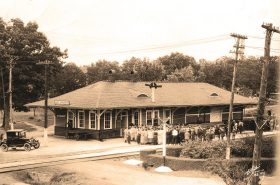Once a bustling train station, Mill Point depot played an important role in Elon’s history.

Unlike today, most students attending classes at Elon in the autumn of 1890 arrived at the newly built college by train. They got off at the Mill Point depot, near where the School of Communications’ Snow Atrium now stands.
While the blare of the train whistle is no stranger to today’s Elon community, the station itself is buried in the past. All that survives of the train stop is a commemorative plaque where the station once stood. It was demolished in 1961 after cars and buses reduced passenger rail usage. College administrators unsuccessfully attempted to keep the train depot in operation, as few people were riding the train. And so, the last passenger train stopped at campus in the late 1940s.
The history of the railroad that passes through Elon dates back to the 1850s. Following emancipation, an African-American community established its roots south of the railroad tracks, which roughly paralleled Buffalo Road. That location was ideal for unloading factory wagons after cotton mills began production at Altamahaw and Ossipee in the early 1880s, making the railway stop at Mill Point a popular one during an important part of Elon’s history.
The train depot was not only built for handling freight cars. The railroad was also an essential method of transportation for a majority of Elon College students. By 1900, six passenger trains ran through Elon every day. The depot was located across from the post office, and four mail trains came through Elon on a daily basis. A 1981 article in The Pendulum, the student-run newspaper, recalls that “The ‘coming in’ of the train was a big attraction for townspeople as well as students. Virtually everyone turned out to watch the train pass through town.” The townspeople also met students there when they arrived and saw them off at the end of each term.
 The railroad has many stories to tell. There was a train derailment in 1908 only a few hundred yards east of the station. According to Durward T. Stokes’ book “Elon College: Its History and Traditions,” the wreck involved an evening passenger train and was caused by spreading rails. The engine flipped on its side, as did the coal car. While no one was hurt, the fireman and engineer experienced “narrow escapes,” Stokes writes. Local citizens rushed to help, offering their homes to the unfortunate passengers, while the engineer was taken into a nearby home for first aid.
The railroad has many stories to tell. There was a train derailment in 1908 only a few hundred yards east of the station. According to Durward T. Stokes’ book “Elon College: Its History and Traditions,” the wreck involved an evening passenger train and was caused by spreading rails. The engine flipped on its side, as did the coal car. While no one was hurt, the fireman and engineer experienced “narrow escapes,” Stokes writes. Local citizens rushed to help, offering their homes to the unfortunate passengers, while the engineer was taken into a nearby home for first aid.
A similar happy ending was experienced in 1911. What started as a harmless joke suggesting one of the male students in East Dormitory needed a bath quickly escalated, with the student being dropped in a bathtub of water. He reported the perpetrators to the school and the faculty later ruled that this was a case of hazing and expelled the group of students involved. The culprits signed a plea for mercy, but were unsuccessful in their appeal. They packed their belongings and headed to the train station, awaiting the arrival of the morning train. As they waited, a petition to reverse the decision was signed by 102 students as well as the victim. This was enough to convince faculty members to reinstate the seven culprits, just before the morning train arrived. Had they not been awaiting the train’s arrival, these seven students might have had to say goodbye to Elon.
Today few people remain who remember the station and the impact it once had on the community. An excerpt in the Alumni News Bulletin from March 1963 says that there was a strong sense of nostalgia surrounding the station shortly after it was demolished. “The joy of going ‘down to the station’ to meet the trains (girls chaperoned of course); the anticipation of meeting the trains in September to see who was coming back, since nearly everyone traveled by trains; the farewells in May as students departed for the summer vacation months. But these days are gone forever and for the old station is gone and only two trains daily—one east, one west—and if you want to ride, you flag!”


